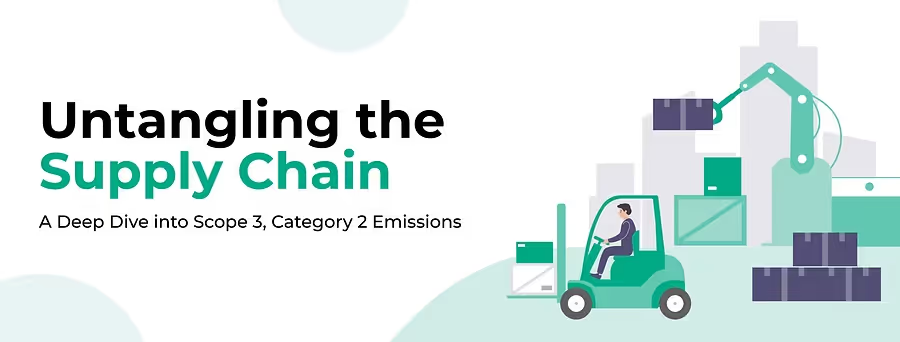
Solutions
Carbon Management
ESG Intelligence
Climate & Nature Risk
Data Registry
Beta
Sector
Get started, schedule a demo or request a free assessment!


In today's environmentally conscious landscape, businesses are increasingly scrutinized for their carbon footprint. While many prioritize direct emissions (Scope 1) and purchased electricity (Scope 2), a hidden giant lurks in the shadows: Scope 3, Category 2 emissions. These emissions, arising from the production of purchased capital goods, represent a significant chunk of an organization's total carbon footprint, often exceeding direct emissions. So, what are these elusive Category 2 emissions, and why should you care?
As defined by the GHG Protocol, Scope 3, Category 2 includes all upstream (i.e., cradle-to-gate) emissions from the production of capital goods purchased or acquired by the reporting company in the reporting year. Emissions from the use of capital goods by the reporting company are accounted for in either scope 1 (e.g., for fuel use) or scope 2 (e.g., for electricity use), rather than in scope 3.
Imagine a factory churning out machinery you buy for your own production line. While your Scope 1 emissions account for the fuel used within your factory and Scope 2 covers the electricity powering it, the emissions generated during the production of that machinery fall under Scope 3, Category 2. This includes:
Essentially, Category 2 captures the upstream carbon footprint embedded within your purchased equipment, highlighting the hidden environmental cost of doing business.
For many businesses, Category 2 emissions can be a significant contributor to their overall carbon footprint. Measuring and understanding Category 2 emissions empowers you to:
The GHG Protocol highlights 4 different ways of calculating and measuring Scope 3 Category 2 emissions, which are the same as the methods for calculating Scope 3, Category 1 emissions:
1. Supplier-specific method: involves collecting product-level cradle-to-gate GHG inventory data from goods suppliers
2. Hybrid method: involves a combination of supplier-specific activity data (as and where available) and using secondary data to fill the gaps. This method involves:
3. Average-product method: involves estimating emissions for goods by collecting data on the mass or other relevant units of goods purchased and multiplying by relevant secondary (e.g., industry average) emission factors (e.g., average emissions per unit of good)
4. Average spend-based method: involves estimating emissions for goods by collecting data on the economic value of goods purchased and multiplying by relevant secondary (e.g., industry average) emission factors (e.g., average emissions per monetary value of goods).
For guidance on calculating emissions from Scope 3 Category 2 Emissions, we recommend referring to the Technical Guidance for Calculating Scope 3 Emissions Document
Once you have your Category 2 emissions calculated, it's time to analyze and set reduction targets:
The fight against Category 2 emissions requires a multi-pronged approach. Here are some tools in your arsenal:
Navigating the complexities of Scope 3, Category 2 emissions can be overwhelming and that's where StepChange comes in. Our ESG software offers a comprehensive solution to help you measure, analyze, and reduce your emissions throughout your supply chain.
The platform streamlines data collection through seamless integrations with various sources, including supplier portals and enterprise softwares. With powerful analytics dashboards, you can identify hotspots, track progress, and benchmark your performance against industry leaders. By leveraging our ESG software, you can gain valuable insights into your Category 2 emissions, empowering you to make informed decisions, collaborate effectively with suppliers, and ultimately, contribute to a more sustainable future.
Remember, tackling Category 2 emissions is not just a compliance checkmark, it's an opportunity to unlock innovation, strengthen your brand, and drive long-term business success. Take the first step today and explore how StepChange can help you on your sustainability journey.

.svg)